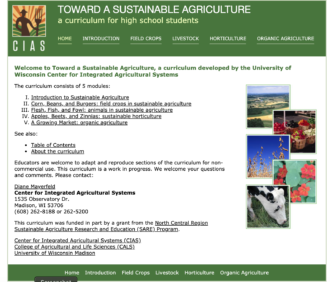Toward a Sustainable Agriculture is a high school curriculum developed by the University of Wisconsin-Madison Center for Integrated Agricultural Systems.
This free high-school curriculum addresses agriculture's social, environmental, and economic impacts. The curriculum critically analyzes agricultural and food systems and helps students understand new concepts through hands-on examples. The curriculum includes six modules designed to be incorporated into existing classes.
This curriculum was developed by the Center for Integrated Agricultural Systems (CIAS) at the University of Wisconsin-Madison College of Agricultural and Life Sciences (CALS). A grant from NCR-SARE partly funded its development.
The following key themes inform the whole curriculum:
- Sustainable agriculture addresses social, environmental, and economic impacts.
- Food system and agroecosystem analysis offer critical theoretical frameworks for understanding agriculture.
- Sustainable agriculture is defined and driven by goals. Practices are sustainable only insofar as they support those goals. Thus, the same practice may be sustainable in one context and unsustainable in another.
- Real-world examples provide the best opportunity to understand the potential and challenges of sustainable agriculture. The curriculum provides some case study examples, but teachers are strongly encouraged to introduce students to people engaged in sustainable agriculture or food businesses in their immediate area.
The curriculum is divided into six modules. Each module is designed to be taught in as little as 5 hours of class time (or one week), though it will take longer if you choose to use all the material in the module. The modules are designed to be taught independently. However, we strongly recommend that teachers ensure that their students are familiar with the basic concepts covered in Module I before proceeding to any of the other modules. These basic concepts can be introduced (or reviewed) in about two hours.
- Introduction to Sustainable Agriculture
- Corn, Beans, and Burgers: field crops in sustainable agriculture
- Flesh, Fish, and Fowl: animals in sustainable agriculture
- Apples, Beets, and Zinnias: sustainable horticulture
- A Growing Market: Organic Agriculture
- Urban Agriculture
See also:
Educators are welcome to adapt and reproduce curriculum sections for non-commercial use. This curriculum is a work in progress.
Want more information? See the related SARE grant:
This material is based upon work that is supported by the National Institute of Food and Agriculture, U.S. Department of Agriculture through the Sustainable Agriculture Research and Education (SARE) program. Any opinions, findings, conclusions, or recommendations expressed in this publication are those of the author(s) and should not be construed to represent any official USDA or U.S. Government determination or policy.
